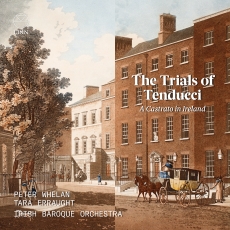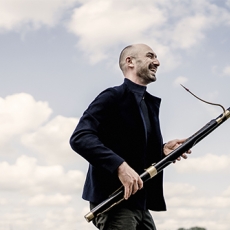IBO & Peter Whelan - The Trials of Tenducci - Planet Hugill
A delightful journey through the eventful musical life of soprano castrato Tenducci whose performing career encompassed London, Dublin and Edinburgh.
The Italian soprano castrato Giusto Ferdinando Tenducci (c. 1735–90) seems to have had a remarkably eventful life, including a period in a debtors' prison in Southwark, a short period on the run, becoming secretly married to a 16-year-old which involved, flight, trial and imprisonment (and evenutually the marriage was annulled). He was also reputed, by Casanova, to have father two children but these are thought to be his wife's offspring by her second husband. But Tenducci also found time to sing and much of his career was in Britain and Ireland. On this new disc, The Trials of Tenducci: A castrato in Ireland from Linn Records, the Irish Baroque Orchestra, conductor Peter Whelan and mezzo-soprano Tara Erraught explore music associated with Tenducci, particularly his period in Dublin. We all know about the premiere of Handel's Messiah in Dublin, but Baroque music in Ireland was far richer than just that one work and part of the Irish Baroque Orchestra's mission is to explore this.
From the mid-18th century onwards, the music scene in Dublin was lively and tempted all sorts of visitors as George Frideric Handel's success in the city in the 1740s testifies. The disc opens with a Symphony in G by Pierre van Maldere (1729-1768), a violinist who arrived in 1751 having previously worked at the Brussels court of Prince Charles Alexander of Lorraine. For two years, Van Maldere was a leading light of the concert series held at Fishamble Street’s Philharmonic Room and this symphony may well have been written in Dublin. In three movements it is engagingly 'Mozartian', a toe-tapping Allegro assai, elegantly gentle Andantino and robust Presto.
Tenducci had come to London in 1758 and started off singing secondary roles. But he would go on to become something of a superstar, and be painted twice by Gainsborough. Tenducci's big break was in Thomas Arne's Artaxerxes in London in 1762, an English language opera seria (rather than the more common English ballad opera), based on a libretto by Metastasio. Tenducci sang the role of the hero, Arbaces. He became friends with the composer Johann Christian Bach and sang in the premiere of Bach's Adriano in Siria at the King's Theatre in London in 1764.
Tenducci repeated the role of Arbaces in Artaxerxes in the first Dublin staging of the work in 1765-1766 when it seems to have been popular as there was a run of 33 performances. Whilst in Dublin at the time Tenducci also arranged operas for the Smock Alley Theatre. We hear two arias from the opera. First the virtuoso ‘Amid a thousand racking woes’ which Erraught sings with warm tone and engaging bravura, well supported by the orchestra in what is quite a substantial instrumental accompaniment. The second aria is the simpler lament, ‘Water parted from the sea’ which understandably became the hit number, so much so that Dublin street boys sang a song about him which was quoted and parodied by James Joyce in Finnegan's Wake.
The Italian composer, Tommaso Giordani (c. 1730–1806) was in Dublin in the 1760s, composing and arranging operas for the Smock Alley and Crow Street Theatres. He would leave in 1769 but return in 1783, staying till his death. He and Tenducci met in the 1760s and Giordani would write songs for the castrato including the tenderly attractive Caro mio ben and Queen Mary's Lamentation, which almost has a Scottish lilt to it (the Queen referred to is Mary Queen of Scots). Both were published in 1783 'as sung by Signor Tenducci' and in London Tenducci had performed them at the Hanover Square Rooms concert series (then run by Carl Friedrich Abel after Johann Christian Bach's death). Giordani also explored Irish tunes, and wrote music for James Messink’s 1785 pantomime, The Island of Saints, or The Institution of the Shamrock and we hear the overture and Irish medley from this. These are three short-ish movements though only the final medley seems full of Irish tunes combined in lively 18th century style
Johann Christian Bach was in fact another of Tenducci's friends and the pair of names interlink in various ways. It was probably for Tenducci that Bach arranged an aria from Michele Mortellari’s Arsace, an opera that had premiered with Tenducci in the title role in Padua in 1775, with Bach adding obbligato parts for oboe and fortepiano to the voice and strings to create a scena, Ebben si vada – Io ti lascio. This starts with a very dramatic accompanied recitative which certainly reminds you of Mozart's debt to the composer, and this develops into a lyrical aria in which Bach imaginatively uses the timbres of the fortepiano and oboe.
At some point Tenducci and Bach performed the aria in London with Johann Christian Fischer playing oboe. Fischer had settled in London in 1768 member of Queen Charlotte’s band of musicians and highly sought after soloist at public at public concerts. Intriguingly the final movement of Fischer's Oboe Concerto No. 7 is a set of variations on the Irish folk-song, Gramachree Molly, the music starts out liltingly but as the variations developed Fischer's writing gets suitably elaborate, all beautifully played by soloist Andreas Helm.
When Tenducci visited Edinburgh in the 1760s for the Scottish premiere of Artaxerxes, he got Bach to arrange some Scottish songs for him which were included in the production (!). Two have been lost, but we are able to hear Bach's version of The Braes of Ballenden.
In 1778, Bach was in Paris auditioning singers for the production of his opera Amadis de Gaule and Tenducci was with him. Also in Paris at the time was Mozart, to whom Tenducci taught singing. Mozart wrote to his father ‘Tenducci is here … He is Bach’s bosom friend. He also was greatly delighted to see me again … I am composing a scena for Tenducci, which is to be performed on Sunday; it is for pianoforte, oboe, horn and bassoon’ (27 August 1778). Frustratingly, the work is now lost, so the performers complete the programme with another work by Mozart written in the 1770s for another star castrato, sacred motet Exsultate, jubilate, K. 165, which was premiered at Milan’s Theatine Church in January 1773 by Venanzio Rauzzini.
Soloist and ensemble are on fine form here with an opening movement with an engaging swagger to it. Whelan's speeds are quite brisk, but the passagework from Erraught is suitably joyful. The second aria is elegantly graceful whilst the concluding Alleluia is suitably bravura. The fact that Erraught, a mezzo-soprano, is singing a part usually sung by sopranos is an indication that soprano castrato voices were often closer to high mezzo-soprano in range.
By 1783 Tenducci was back in Dublin where he was planning to settle and to teach, but he seems to have remained just as restless as ever and in 1785 he published a treatise of singing, Instruction of Mr. Tenducci to his Scholars (1785) in London.
Peter Whelan directs from the fortepiano and the orchestra consists of 11 strings, oboes, bassoon and horns, and the disc was recorded in a period-appropriate venue, a lovely 18th century church in Drogheda. The musicians are on terrific form, whether it be giving us Mozartian (or Bachian) grace or launching into Irish folk tunes. In the aris Tara Erraught both engages and impresses, she sings with a lovely warm tone yet can whizz through the passagework as well.
This is a lovely, imaginative disc which provides interesting highlights of a singer who was clearly heavily involved in both the English and Irish music scenes. The disc is the second of the orchestra's planned series of five on Linn telling the rich stories of Ireland's Baroque era (the first disc was Welcome Home, Mr Dubourg). Assembling this sort of programme is always tricky, as even if we know what was performed at a particular concert the music may no longer exist. Here Whelan and his forces have created an engaging and fascinating recital which draws a number of threads together.



